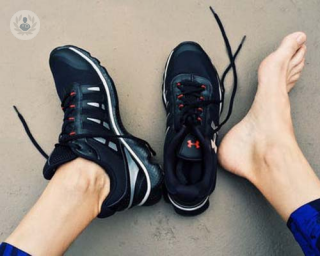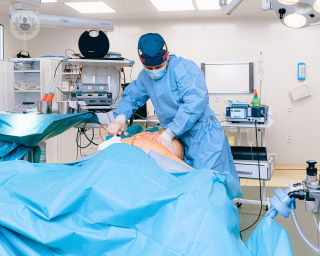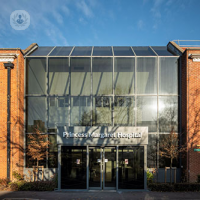What is a sprain?
Sprains and strains are common injuries that affect muscles and ligaments and usually occur at the wrist, hand, ankle or leg. It can take about two weeks for a sprain to improve, with some taking a few months to fully recover.

What are the symptoms of a sprain?
Common symptoms of a sprain include:
- Pain and tenderness around the area sprained, often the ankle, foot, wrist, knee and leg
- Swelling and bruising
- The sprained part of your body cannot be used as normal or carry much weight
- Muscle spasms or cramps
What causes a sprain?
Sprains can happen when you:
- Overstretch or twist a muscle
- Don’t warm up before exercising
- Have tired muscles
- Playing sports
How is a sprain diagnosed?
Sprains can be diagnosed with your GP, however, if you feel pain and inflammation after playing sports or twisting and find it hard to bare weight on that part of your body, then you more than likely have a sprain.
How is a sprain treated?
Most sprains can be treated at home, without intervention. For the first few days following the sprain, the four steps of RICE therapy should be followed to help bring down the swelling and support the sprain.
- Rest: avoid exercise and activities and don’t put any weight on the injury
- Ice: apply ice or a bag of frozen vegetables to the injury for 20 minutes every two to three hours
- Compression: wrap a bandage around the injury to give it support
- Elevate: keep the injured muscle raised on a pillow as much as possible
It’s best to avoid heat, massages, hot baths and alcohol for the first few days. Even if exercise should be avoided, it’s recommended to keep moving the injured joint to avoid it becoming stiff. Strenuous exercise should not be carried out for at least eight weeks.
If pain worsens or doesn’t improve, visit your GP who will advise the next steps and suggest painkillers like paracetamol to ease the pain and ibuprofen to reduce inflammation. You may also be required to have an X-ray. Physiotherapy can help with sprains that are taking longer to heal.
If you suddenly get a high temperature and feel hot and shivery, you may have an infection and it is advised to call emergency services for advice.
02-05-2013 06-15-2023Sprain
Mr Jasdeep Giddie - Orthopaedic surgery
Created on: 02-05-2013
Updated on: 06-15-2023
Edited by: Sophie Kennedy
What is a sprain?
Sprains and strains are common injuries that affect muscles and ligaments and usually occur at the wrist, hand, ankle or leg. It can take about two weeks for a sprain to improve, with some taking a few months to fully recover.

What are the symptoms of a sprain?
Common symptoms of a sprain include:
- Pain and tenderness around the area sprained, often the ankle, foot, wrist, knee and leg
- Swelling and bruising
- The sprained part of your body cannot be used as normal or carry much weight
- Muscle spasms or cramps
What causes a sprain?
Sprains can happen when you:
- Overstretch or twist a muscle
- Don’t warm up before exercising
- Have tired muscles
- Playing sports
How is a sprain diagnosed?
Sprains can be diagnosed with your GP, however, if you feel pain and inflammation after playing sports or twisting and find it hard to bare weight on that part of your body, then you more than likely have a sprain.
How is a sprain treated?
Most sprains can be treated at home, without intervention. For the first few days following the sprain, the four steps of RICE therapy should be followed to help bring down the swelling and support the sprain.
- Rest: avoid exercise and activities and don’t put any weight on the injury
- Ice: apply ice or a bag of frozen vegetables to the injury for 20 minutes every two to three hours
- Compression: wrap a bandage around the injury to give it support
- Elevate: keep the injured muscle raised on a pillow as much as possible
It’s best to avoid heat, massages, hot baths and alcohol for the first few days. Even if exercise should be avoided, it’s recommended to keep moving the injured joint to avoid it becoming stiff. Strenuous exercise should not be carried out for at least eight weeks.
If pain worsens or doesn’t improve, visit your GP who will advise the next steps and suggest painkillers like paracetamol to ease the pain and ibuprofen to reduce inflammation. You may also be required to have an X-ray. Physiotherapy can help with sprains that are taking longer to heal.
If you suddenly get a high temperature and feel hot and shivery, you may have an infection and it is advised to call emergency services for advice.


Why is my ankle injury not healing?
By Mr Stefan Weitzel
2024-11-21
Ankle injuries are very common and while most are mild sprains and typically take 2-4 weeks to heal, some may take even longer. However, you should always be noticing a gradual improvement in your symptoms as time goes by, and if you aren't, it can indicate something more serious. Mr Stefan Weitzel, one of our top consultant orthopaedic surgeons, explains what you should do if your ankle injury doesn't show signs of healing. See more


How to treat a sports-related ankle sprain
By Mr Peter Craig
2024-11-19
Sports-related ankle injuries are very common. But would do you know what to do as soon as it happens? We've asked expert orthopaedic surgeon Mr Peter Craig to explain how to manage a lateral ligament ankle injury. See more


Your quick recovery guide to strains, sprains and breaks
By Professor Ali Ghoz
2024-11-17
Injuries to joints, muscles, ligaments and bones happen to us all at some point in our lives. Professor Ali Ghoz, a consultant trauma and orthopaedic surgeon based in London, explains how to effectively manage these injuries and what to expect during the recovery period. See more


How is orthopaedic surgery being affected by COVID-19?
By Mr Tarek El Gamal
2024-11-09
Accidents happen. And sometimes, these accidents need emergency care which could mean going into surgery. During the COVID-19 pandemic, it may be worrying no knowing how this crisis is affecting trauma-related hospital treatments and what your next steps are if you've hurt yourself. Mr Tarek El Gamal, an expert orthopaedic surgeon, explains more. See more
Experts in Sprain
-
Mr Tim Sinnett
Orthopaedic surgeryExpert in:
- Foot and ankle
- Plantar fasciitis
- Foot fracture
- Tendonitis
- Sprain
- Osteoarthritis of the ankle
-
Mr Jasdeep Giddie
Orthopaedic surgeryExpert in:
- Traumatic injury
- Bunion (hallux valgus)
- Sports injuries
- Osteoarthritis of the ankle
- Sprain
- Diabetic foot
- See all

The Princess Margaret Hospital - part of Circle Health Group
The Princess Margaret Hospital - part of Circle Health Group
Osborne Rd, Windsor SL4 3SJ
No existe teléfono en el centro.
By using the telephone number provided by TOP DOCTORS, you automatically agree to let us use your phone number for statistical and commercial purposes. For further information, read our Privacy Policy
Top Doctors

The Parkside Suite Wexham
The Parkside Suite Wexham
Wexham Park Hospital, SL2 4HL, Berkshire
No existe teléfono en el centro.
By using the telephone number provided by TOP DOCTORS, you automatically agree to let us use your phone number for statistical and commercial purposes. For further information, read our Privacy Policy
Top Doctors

New Victoria Hospital
New Victoria Hospital
184 Coombe Lane West, Kingston upon Thames, KT2 7EG
No existe teléfono en el centro.
By using the telephone number provided by TOP DOCTORS, you automatically agree to let us use your phone number for statistical and commercial purposes. For further information, read our Privacy Policy
Top Doctors
-
The Princess Margaret Hospital - part of Circle Health Group
Osborne Rd, Windsor SL4 3SJ, WindsorExpert in:
- Brachytherapy
- Cardiology
- General Surgery
- Orthopaedic surgery
- Robotic Surgery
- Dermatology
-
The Parkside Suite Wexham
Wexham Park Hospital, SL2 4HL, Berkshire, WexhamExpert in:
- Colorectal surgery
- General Surgery
- Breast augmentation
- Dermatology
- Obstetrics and Gynaecology
- Medical Oncology
-
New Victoria Hospital
184 Coombe Lane West, Kingston upon Thames, KT2 7EG, South LondonExpert in:
- Cardiology
- General Surgery
- Orthopaedic surgery
- Breast augmentation
- Pain management
- Spine
- See all
- Most viewed diseases, medical tests, and treatments
- Joint pain
- Lumbar herniated disc
- Spinal surgery
- Minimal access surgery (keyhole surgery)
- Shoulder pain
- Osteoporosis
- Botulinum toxin (Botox™)
- Abnormal gait
- Shoulder osteoarthritis
- DEXA scan




